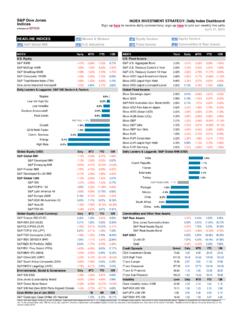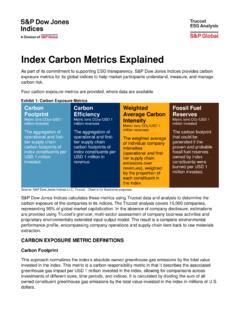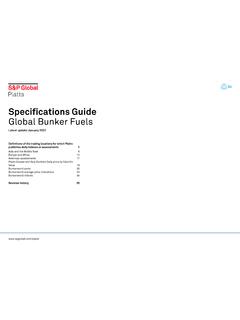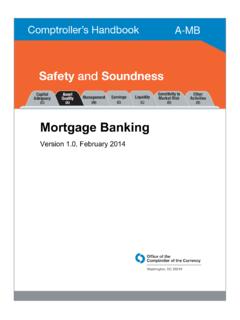Transcription of Guide to Credit Rating Essentials - S&P Global
1 Guide to Credit Rating EssentialsWhat are Credit ratings and how do they work?ContentsAbout this Guide 3 What are Credit ratings 4 Why Credit ratings are useful 6 Who uses Credit ratings 8 Credit Rating agencies 10 The ABCs of Rating scales 13 Rating issuers and issues 15 Surveillance18 Why Credit ratings change 19 How we communicate Credit ratings21 Guide To Credit Rating EssentialsThis Guide is designed to provide an understanding of what Credit ratings are and how they Guide :1. Helps explain what Credit ratings are and are not, who uses them and how they may be useful to the capital Provides an overview of different business models and methodologies used by different ratings Describes generally how S&P Global ratings form ratings opinions about issuers and individual debt issues, monitors and adjusts its ratings and studies ratings changes over ratings are a tool, among others, that investors can use when making decisions about purchasing bonds and other fixed income investments.
2 ratings help foster the development and smooth functioning of capital markets; capital allows people to start and grow businesses, cities and states to build highways and hospitals, and manufacturers to build factories and create jobs. ratings express independent opinions on creditworthiness, using a common terminology that may help investors make more informed investment Global ratings is a leading provider of independent Credit ratings and analysis, offering a combination of Global perspective with local insight. We update and refine our processes, from time to time, to align with new developments in the marketplace, enabling us to offer insightful opinions that help market participants make more informed investment this Guide If you would like to learn more about Credit ratings , additional information is available at to Credit Rating Essentials4 ratings are opinions about Credit risk.
3 Our ratings express the agency s opinion about the ability and willingness of an issuer, such as a corporation or state or city government, to meet its financial obligations in full and on time. Credit ratings can also speak to the Credit quality of an individual debt issue, such as a corporate or municipal bond, and the relative likelihood that the issue may default. ratings are provided by Credit Rating agencies which specialize in evaluating Credit risk. In addition to international Credit Rating agencies, such as S&P Global ratings , there are regional and niche Rating agencies that tend to specialize in a geographical region or industry.
4 Each agency applies its own methodology in measuring creditworthiness and uses a specific Rating scale to publish its ratings opinions. Typically, ratings are expressed as letter grades that range, for example, from AAA to D to communicate the agency s opinion of relative level of Credit are Credit ratings Guide to Credit Rating Essentials 54 ratings are forward lookingAs part of its ratings analysis, S&P Global ratings evaluates available current and historical information and assesses the potential impact of foreseeable future events. For example, in Rating a corporation as an issuer of debt, the agency may factor in anticipated ups and downs in the business cycle that may affect the corporation s creditworthiness.
5 While the forward looking opinions of Rating agencies can be of use to investors and market participants who are making long- or short-term investment and business decisions, Credit ratings are not a guarantee that an investment will pay out or that it will not ratings do not indicate investment meritWhile investors may use Credit ratings in making investment decisions, our ratings are not indications of investment merit. In other words, the ratings are not buy, sell, or hold recommendations, or a measure of asset value. Nor are they intended to signal the suitability of an investment.
6 They speak to one aspect of an investment decision Credit quality and, in some cases, may also address what investors can expect to recover in the event of evaluating an investment, investors should consider, in addition to Credit quality, the current make-up of their portfolios, their investment strategy and time horizon, their tolerance for risk, and an estimation of the security s relative value in comparison to other securities they might choose. By way of analogy, while reputation for dependability may be an important consideration in buying a car, it is not the sole criterion on which drivers normally base their purchase ratings are not absolute measures of default probabilitySince there are future events and developments that cannot be foreseen, the assignment of Credit ratings is not an exact science.
7 For this reason, S&P Global ratings opinions are not intended as guarantees of Credit quality or as exact measures of the probability that a particular issuer or particular debt issue will default. Instead, ratings express relative opinions about the creditworthiness of an issuer or Credit quality of an individual debt issue, from strongest to weakest, within a universe of Credit risk. For example, a corporate bond that is rated AA is viewed by the Rating agency as having a higher Credit quality than a corporate bond with a BBB Rating . But the AA Rating isn t a guarantee that it will not default, only that, in the agency s opinion, it is less likely to default than the BBB Global ratings public Credit ratings opinions are disseminated broadly and free of charge to recipients all over the world on matter of opinionOur ratings opinions are based on analysis by experienced professionals who evaluate and interpret information received from issuers and other available sources to form a considered opinion.
8 Unlike other types of opinions, such as, for example, those provided by doctors or lawyers, Credit ratings opinions are not intended to be a prognosis or recommendation. Instead, they are primarily intended to provide investors and market participants with information about the relative Credit risk of issuers and individual debt issues that the agency states, cities, and other municipalities to fund public the same time, Credit ratings may be used:Why Credit ratings are useful Credit ratings may play a useful role in enabling corporations and governments to raise money in the capital markets.
9 Instead of taking a loan from a bank, these entities sometimes borrow money directly from investors by issuing bonds or notes. Investors purchase these debt securities, such as municipal bonds, expecting to receive interest plus the return of their principal, either when the bond matures or as periodic payments. Credit ratings may facilitate the process of issuing and purchasing bonds and other debt issues by providing an efficient, widely recognized, and long-standing measure of relative Credit risk. Credit ratings are assigned to issuers and debt securities as well as bank loans.
10 Investors and other market participants may use the ratings as a screening device to match the relative Credit risk of an issuer or individual debt issue with their own risk tolerance or Credit risk guidelines in making investment and business instance, in considering the purchase of a municipal bond, an investor may check to see whether the bond s Credit Rating is in keeping with the level of Credit risk he or she is willing to assume. Guide to Credit Rating Essentialsby corporations to help them raise money for expansion and/or research and development. 6 capital through rated securitiesIssuersIntermediariesPurchase rated securitiesIssue rated securities to raise capitalInvestorsGuide to Credit Rating Essentials 78 uses Credit ratings InvestorsInvestors most often use Credit ratings to help assess Credit risk and to compare different issuers and debt issues when making investment decisions and managing their portfolios.













